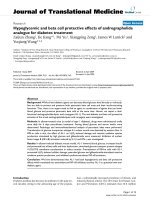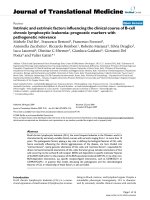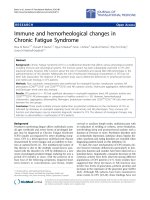báo cáo hóa học:" Emotion and mental state recognition from speech" ppt
Bạn đang xem bản rút gọn của tài liệu. Xem và tải ngay bản đầy đủ của tài liệu tại đây (92.32 KB, 8 trang )
This Provisional PDF corresponds to the article as it appeared upon acceptance. Fully formatted
PDF and full text (HTML) versions will be made available soon.
Emotion and mental state recognition from speech
EURASIP Journal on Advances in Signal Processing 2012,
2012:15 doi:10.1186/1687-6180-2012-15
Julien Epps ()
Roddy Cowie ()
Shrikanth Narayanan ()
Bjorn Schuller ()
Jianhua Tao ()
ISSN 1687-6180
Article type Editorial
Submission date 8 December 2011
Acceptance date 19 January 2012
Publication date 19 January 2012
Article URL />This peer-reviewed article was published immediately upon acceptance. It can be downloaded,
printed and distributed freely for any purposes (see copyright notice below).
For information about publishing your research in EURASIP Journal on Advances in Signal
Processing go to
/>For information about other SpringerOpen publications go to
EURASIP Journal on Advances
in Signal Processing
© 2012 Epps et al. ; licensee Springer.
This is an open access article distributed under the terms of the Creative Commons Attribution License ( />which permits unrestricted use, distribution, and reproduction in any medium, provided the original work is properly cited.
Emotion and mental state recognition from speech
Julien Epps
*1,2
, Roddy Cowie
3
, Shrikanth Narayanan
4
, Björn Schuller
5
and
Jianhua Tao
6
1
School of Electrical Engineering and Telecommunications, The University
of New South Wales, Sydney, NSW 2052, Australia
2
ATP Research Laboratory, National ICT Australia (NICTA), Eveleigh,
NSW 2015, Australia
3
Queen’s University, Belfast BT7 1NN, Northern Ireland
4
Department of Electrical Engineering, Viterbi School of Engineering,
University of Southern California, Los Angeles, CA 90089, USA
5
Institute for Human-Machine Communication, Technische Universität
München, 80290 München, Germany
6
National Laboratory of Pattern Recognition, Institute of Automation,
Chinese Academy of Sciences, Beijing 100080, China
*
Corresponding author:
Email addresses:
JE:
RC:
SN:
BS:
JT:
As research in speech processing has matured, attention has gradually
shifted from linguistic-related applications such as speech recognition
towards paralinguistic speech processing problems, in particular the
recognition of speaker identity, language, emotion, gender, and age.
Determination of a speaker’s emotion or mental state is a particularly
challenging problem, in view of the significant variability in its expression
posed by linguistic, contextual, and speaker-specific characteristics within
speech. In response, a range of signal processing and pattern recognition
methods have been developed in recent years.
Recognition of emotion and mental state from speech is a fundamentally
multidisciplinary field, comprising contributions from psychology, speech
science, linguistics, (co-occurring) nonverbal communication, machine
learning, artificial intelligence and signal processing, among others. Some of
the key research problems addressed to date include isolating sources of
emotion-specific information in the speech signal, extracting suitable
features, forming reduced-dimension feature sets, developing machine
learning methods applicable to the task, reducing feature variability due to
speaker and linguistic content, comparing and evaluating diverse methods,
robustness, and constructing suitable databases. Studies examining the
relationships between the psychological basis of emotion, the effect of
emotion on speech production, and the measurable differences in the speech
signal due to emotion have helped to shed light on these problems; however,
substantial research is still required.
Taking a broader view of emotion as a mental state, signal processing
researchers have also explored the possibilities of automatically detecting
other types of mental state which share some characteristics with emotion,
for example stress, depression, cognitive load, and ‘cognitive epistemic’
states such as interest, scepticism, etc. The recent interest in emotion
recognition research has seen applications in call centre analytics, human–
machine and human–robot interfaces, multimedia retrieval, surveillance
tasks, behavioural health informatics, and improved speech recognition.
This special issue comprises nine articles covering a range of topics in signal
processing methods for vocal source and acoustic feature extraction,
robustness issues, novel applications of pattern recognition techniques,
methods for detecting mental states and recognition of non-prototypical
spontaneous and naturalistic emotion in speech. These articles were accepted
following peer review, and each submission was handled by an editor who
was independent from all authors listed in that manuscript. Herein, we
briefly introduce the articles comprising this special issue.
Trevino, Quatieri and Malyska bring a new level of sophistication to an old
problem, detecting signs of depressive disorders in speech. Their measures
of depression come from standard psychiatric instruments, Quick Inventory
of Depressive Symptomatology and Hamilton Depression rating scales.
These are linked to measures of speech timing that are much richer than the
traditional global measures of speech rate. Results indicate that different
speech sounds and sound types behave differently in depression, and may
relate to different aspects of depression.
Caponetti, Buscicchio and Castellano propose the use of a more detailed
auditory model than that embodied in the widely employed Mel frequency
cepstral coefficients, for extracting detailed spectral features during emotion
recognition. Working from the Lyon cochlear model, the authors
demonstrate improvements on a five-class problem from the speech under
simulated and actual stress database. Their study also further validates the
applicability of long short-term memory recurrent neural networks for
classification in emotion and mental state recognition problems.
Callejas, Griol and López-Cózar propose a mental state prediction approach
that considers both speaker intentions and emotions in a spoken dialogue
context. Their system comprises an emotion recognizer that relies on the
user’s speech and dialogue history, and an intention recognizer that relies on
the user input and the system’s prompt. Experiments were carried out using
an academic information dialogue system, and validated with both simulated
and real users, and results show improved interaction efficacy.
Tao et al. present a method for providing an audio-visual mapping between
neutral speech content and neutral facial expression that is then used to
contrast with observed, emotional audio-video data for emotion recognition.
This approach yields a degree of independence between the facial expression
and the uttered expression, which are known to exhibit conflicting
information during some instances of spontaneous face-to-face
communication. The method provides advantages over four more
conventional bimodal emotion recognition methods, when evaluated on a
six-emotion semi-natural audio-video database.
An investigation of the effect of cognitive load on a variety of vocal tract
parameters is reported by Yap, Epps and Ambikairajah. Their analysis of
two databases, comprising a laboratory-style Stroop task and a more
naturalistic reading comprehension task, finds that formant frequencies are
affected by cognitive load, in particular the slope, range and duration of the
formant trajectory. In classification experiments, the first three formant
frequencies were found to provide comparable or improved performance
relative to the Mel frequency cepstral coefficients, which have a much
higher feature dimension.
Pon-Barry and Shieber propose the use of phrase-level prosodic features for
inferring the level of a speaker’s self-reported uncertainty. Following a
description of methods for creating an ‘uncertainty in speech’ corpus, the
authors study the differences between self-reported uncertainty and
externally perceived uncertainty. Their investigation of the effects of
uncertainty on a range of prosodic features forms the basis for an uncertainty
classification system, which achieves encouraging accuracies that are further
increased when phrase-level prosodic features are used in combination with
prosodic features from ‘target words’ elicited using their methods.
The article by Weninger et al. describes the application of non-negative
matrix factorization, employed with success in robust speech recognition, to
noisy emotion recognition. Experiments on the FAU Aibo Emotion Corpus
degraded by babble and street noise show that the technique is promising,
particularly for realistic conditions of low signal-to-noise ratio and for
mismatched training and test data.
Hansen, Kim and Rahurkar demonstrate examples of substantial
improvements to emotion recognition by subband weighting of the Teager
energy operator-based critical band autocorrelation envelope feature. The
empirically derived subband weights were also found to reduce speaker
dependency, when evaluated on a novel speech under stress database with
physiological ground truth.
Finally, Iliev and Scordilis report details of a method for estimating the
symmetry of the glottal pulse, and the extent to which it can characterise
emotion in speech. Their method, which extracts information on the relative
durations of the glottal opening and closing phases from inverse filtered
speech, performs very effective classification for a single-dimension feature,
when evaluated on a six-emotion-acted speech database.
Through these articles, this issue provides avenues for recognizing mental
states more robustly in disturbed audio feeds and with less dependence on
the speaker and facial expression. This is obtained by auditory modelling,
improved or novel feature types, phone-specific information, spectral
decomposition and context exploitation. The articles further cover a broad
range of affective states, reaching from depression disorders to cognitive
load, and general emotion.
Competing Interests
The authors declare that they have no competing interests.
Acknowledgements
The guest editors would like to thank the EURASIP JASP Editor-in-Chief,
Prof. Phillip Regalia, for the opportunity to coordinate this special issue, and
the anonymous reviewers for their diligent work, without which this special
issue would not have been possible.









